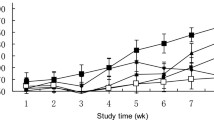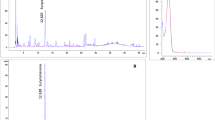Abstract
Objective: To compare the therapeutic effect of Compound Recipe Gengniankang (GNK) with that of hormone replacement treatment (HRT) on climacteric female rats with osteoporosis, and to investigate the roles of estrogen and estrogen receptors in the mechanism of osteoporosis.Methods: Climacteric female rats with osteoporosis were chosen and divided into three groups (GNK group, HRT group and control group). Apoptosis of ovarian granulose cells was measured by terminal-deoxynucleotidyl transferae mediated nick end labeling (TUNEL) assay. Serum level of estrdiol (E2), follicle stimulating hormone (FSH), luteinizing hormone (LH) were determined by the method of radioimmunoassay (RIA). Reverse transcriptase polymerase chain reaction (RT-PCT) technology was used to evaluate the expression of estrogen receptor (ER) in bone. Bone mineral density (BMD) was measured by double energy X-ray absorption (DEXA).Results: In the climacteric rats, BMD, serum E2, ER mRNA expression in bone decreased remarkably, and serum FSH, LH and apoptosis of ovarian granulose cells increased obviously. After treating with GNK, all the indexes were reversed except serum E2. The increase of E2 was not significant.Conclusion: GNK is effective on climacteric osteoporosis female rats. Its role is performed not by increasing serum E2 but by enhancing ER in the bone and inhibiting apoptosis of ovarian granulose cells. GNK can deter further exhaustion of ovarian function.
Similar content being viewed by others
References
Huber J. Phytoestrogens and SERMS, alternatives to classical hormone therapy? Ther Umsch 2000;57(10): 651–654.
Zhi HY, Li E. Effects of replenishing herbs and recipes on ER expression of bone tissue on ovariectomized rats osteoporosis. Chin J TCM Bas Med 2001;7 (4): 281–284.
Riggs BL, Hartmann LC. Selective estrogen-receptor modulators-mechanisms of action and application to clinical practice. N Engl J Med 2003;348(7): 618–629.
American College of Obstetricians and Gynecologists Committee on Practice Bulletins — Gynecology. ACOG Practice Bulletin. Selective estrogen receptor modulators. Int J Gynaecol Obstet 2002; 79(3): 289–298.
Tremollieres F, Lopes P. Specific estrogen receptor modulators (SERMs). Presse Med 2002;31 (28): 1323–1328.
Littleton-Kearney MT, Ostrowski NL, Cox DA, et al. Selective estrogen receptor modulators: tissue actions and potential for CNS protection. CNS Drug Rev 2002;8(3): 309–330.
Goldstein SR, Nanavati N. Adverse events that are associated with the selective estrogen receptor modulator levormeloxifene in an aborted phase III osteoporosis treatment study. Am J Obstet Gynecol 2002;187(3): 521–527.
Sandberg K. HRT and SERMs: the good, the bad … and the lovely? Trends Endocrinol Metab 2002;13(8): 317–318.
Dowsett M, Bundred NJ, Decensi A, et al. Effect of raloxifene on breast cancer cell Ki67 and apoptosis: a double-blind, placebo-controlled, randomized clinical trial in postmenopausal patients. Cancer Epidemiol Biomarkers Prev 2001;10(9): 961–966.
Cummings SR, Duong T, Kenyon E, et al. Serum estradiol level and risk of breast cancer during treatment with raloxifene. JAMA 2002;287(2): 216–20.
Sirtori CR. Risks and benefits of soy phytoestrogens in cardiovascular diseases, cancer, climacteric symptoms and osteoporosis. Drug Saf 2001;24(9): 665–682.
Xie L, Guo ZQ, Yao GH. TCM syndrome differentiation analysis after osteoporosis of climacterium. Chin J Med Pharmaceut 1999;14(3): 35–39.
Author information
Authors and Affiliations
Corresponding author
Additional information
Supported by Shanxi Key Technology R&D Program (No. 20022074)
Rights and permissions
About this article
Cite this article
Su-hui, W., Jing-fen, S. & Shu-zhen, G. Effect of Compound Recipe Gengniankang on senile sexual hormone and expression of estrogen receptor in bone of climacteric female rats. Chin. J. Integr. Med. 11, 205–208 (2005). https://doi.org/10.1007/BF02836506
Received:
Issue Date:
DOI: https://doi.org/10.1007/BF02836506




